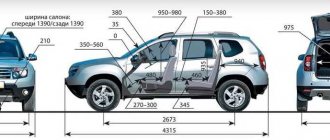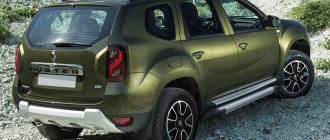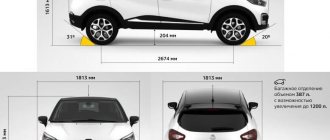The clearance between the ground and the underbody is one of the key characteristics of off-road vehicles. The increased ground clearance of the Renault Duster allows the car to move on dirt or forest roads without the risk of damaging the underbody or transmission elements. As the load increases, the springs compress and the ground clearance decreases, which should be taken into account in off-road conditions.
The importance of clearance
Renault Duster ground clearance refers to the minimum distance measured between the road surface and the lowest point of the car.
The parameter is measured in millimeters on a car with a driver and passenger (without additional protective elements); information is indicated in the reference literature and in the operating instructions. The Russian standard for off-road vehicles and light trucks, adopted in 1993, sets the parameter value at 200 mm.
The size of the gap between the bottom and the ground determines the ability of the car to move along the track. Cars with increased ground clearance can allow road obstacles to pass between the wheels. The front approach angle (30°) partly depends on the ground clearance; the parameter affects the car’s ability to overcome short descents without the risk of contact between the body sills and the ground surface. When the gap between the body and the ground decreases, the rear departure angle changes (factory value 36°), which leads to damage to the bumper when driving over rough terrain.
Now let’s compare the Duster’s ground clearance with other models:
- The ground clearance of the Nissan Qashqai is 200 mm, which is less than that of its French opponent.
- Russian manufacturers, represented by the UAZ Patriot, managed to reach the heights of the Renault Duster - similar to 210 mm.
- The Mitsubishi Outlander, which is an SUV, once went through the homologation procedure. This means that the geometry of the car body has been redesigned. As a result, the developers improved the departure and approach angles, and also achieved a ground clearance of 215 mm.
- Before the latest restyling, the Volkswagen Tiguan DP was 200 mm. But experts did not agree with this, because in some parts of the body the lowest point was only 163 mm from the road.
- The Skoda Yeti, even when fully loaded, can boast a DP of 180 mm.
From the above, we can conclude that the DP indicator of the French model is in no way inferior to those recognized by all SUVs.
Official figures for standard and AWD versions
For Duster cars, the plant declares the following parameters:
- the ground clearance of the version with front drive wheels is 205 mm (the parameter does not depend on the type of power unit and transmission);
- The version with 4x4 drive has a clearance of up to 210 mm.
From what point does the measurement begin?
The gap on vehicles with front-wheel drive is measured between the lower plane of the rear torsion beam and the road.
Crossovers in the AWD configuration are equipped with a multi-link rear suspension, due to which the trajectory of the exhaust tract is changed, and a modified luggage compartment tray is used. Ground clearance is determined by the distance between the muffler can and the ground. The parameters do not depend on the year of manufacture of the SUV, since the manufacturer did not modify the chassis or introduce new power units.
Effect of load on clearance size
The amount of clearance under the body bottom is affected by the vehicle load and tire pressure. For example, with partially deflated wheels, the ground clearance is reduced to 195-197 mm. A similar situation occurs when loading the luggage compartment or transporting passengers in the cabin.
When the passenger compartment and luggage compartment are fully loaded, the clearance decreases by 25-30 mm; installing a trunk with a load on the roof of the car further reduces the ground clearance by 2-3 mm.
Features of Renault Duster ground clearance
It can be difficult to determine what ground clearance a Renault Duster has. This is due to the fact that the ground clearance changes depending on the version of the crossover. The lowest point of Duster is located:
- on the muffler can in all-wheel drive versions;
- on a bracket in single-drive versions.
In the first case, the distance from the supporting surface to the bottom point is 210 mm, in the second - 205 mm.
Moreover, the ground clearance is the same for Renault Duster of the first and second generations.
The figures given are the ground clearance set by the manufacturer. The crossover's ground clearance changes when the vehicle is fully loaded. It is quite difficult to determine how much the Renault Duster's ground clearance will decrease. Therefore, before going off-road in a loaded crossover, you need to take into account the fact of body “sagging”: on average, the latter reaches 20 mm.
Among the features characteristic of Duster, the AWD modification stands out. In this version, the car is complemented by an exhaust pipe that runs along the bottom and significantly reduces the size of the ground clearance.
The distance from the supporting surface to the bottom of the bottom does not always play a key role when moving in poor conditions. In this case, it is also important to pay attention to the geometric cross-country ability. Renault Duster has low overhangs, thanks to which the all-terrain vehicle is able to overcome obstacles at a slope of 30 degrees in the front and 36 degrees in the rear.
The French model, despite belonging to the category of urban SUVs, behaves well in off-road conditions due to the structural features of the body and high ground clearance.
Real ground clearance in different conditions
The gap between the body and the road is a dynamic value, constantly changing depending on the vehicle load and the condition of the tires. For example, in a car manufactured in 2021 with a tire pressure of a standard size of 2 atm. The gap between the muffler body and the asphalt is less than 195 mm, which is 15 mm lower than the value declared by the factory. Increasing pressure to 2.5-2.6 atm. allows you to bring the ground clearance to the passport parameters.
To increase clearance, the following methods are used:
- Installation of tires with an increased profile. This takes into account the dimensions of the wheel arches. The plant uses 215/65R16 tires with an outer diameter of 686 mm. It is possible to install tires of size 225/65 R16, increasing the clearance by 6.5 mm. The maximum tire diameter is 707 mm, which corresponds to size 215/70 R16 and allows you to increase the ground clearance by 10.5 mm. Increasing the size and weight of tires and increasing the air gap under the bottom lead to increased fuel consumption.
- Installation of springs with increased rigidity or with additional coils. Since the suspension characteristics change, it is necessary to install shock absorbers with increased travel. The use of elements makes it possible to increase the clearance by 25-30 mm, while at the same time the gap between the upper surface of the tire and the edge of the wing increases. In this case, you can install standard 225/70 R16 tires with a diameter of 721 mm.
- Installation of spacers between the cups on the suspension arms and the springs, allowing the body to be raised above the ground surface by 10-20 mm. There are elements made of synthetic materials and aluminum. The use of plastic elements leads to distortions of the body when moving (due to different elasticity of steel springs and polyurethane gaskets). Products wear out quickly due to cyclic loads and sand and small stones getting into the gap between the spring and the ring.
- Installation of a new suspension with modified drive shafts (to increase ground clearance by 100-150 mm or more). The power unit and transmission components are subject to modification. Additionally, wheels with an increased diameter and tires with developed off-road tread are installed. Such modernization increases the vehicle's cross-country ability, but modifications require registration.
If the car owner drives on city streets, then larger springs or gaskets should not be installed. Increasing the clearance under the body makes the crossover less stable when driving on the highway, during sharp maneuvers or turns at speed.
Reducing the clearance by trimming the springs is not recommended, since the kinematics of the suspension changes and the wear of shock absorbers and rubber joints is accelerated.
Spacers for Renault Duster
Perhaps the most common way to increase ground clearance on almost all small cars. The principle is simple - we install spacers between the pillar and the body, as a result we get an increase in ground clearance of up to 30 mm. It is highly not recommended to exceed this limit, especially on the front axle. There are a lot of spacer sets for Duster made from a variety of materials - aluminum, polyurethane, different types of rubber.
Interesting on the topic: Choosing a Duster with a diesel engine. Is the game worth the candle?
For the rear suspension, there are spacers with shock absorber rod extensions. For front-wheel drive versions of the Duster, in addition to spacers, it is necessary to install additional brackets on the rear beam to compensate for the shock absorber travel. In this case, the shock absorber will operate in its usual mode and there will be no harm from such tuning. With the help of spacers you can easily increase the ground clearance to 230-240 mm, and this is already a decent figure.
Off-road conditions
When operating a crossover in off-road conditions, the type of power plant should be taken into account. Gasoline engines do not have high torque at low speeds, so the crankshaft must be spinned when driving. When moving “in tightness,” there is a risk of the engine stopping and the car sliding into the rut. A supercharged diesel engine has increased traction at low speeds, which improves the vehicle's off-road performance.\
When driving on rough terrain, be aware that logs and stones can damage the muffler, fuel tank and rear axle gear housing. To protect the elements, shields made of steel sheets are used, which are attached to standard points on the body. Screens reduce ground clearance by 10-15 mm (this depends on the manufacturer of the parts). The plant offers a set of original steel cranes; the cost of the set with installation is 11 thousand rubles.
How to install spacers yourself
Increasing the ground clearance of Duster using spacers is carried out in the following stages:
- unscrew the fastening nuts and remove the wheel;
- the nut securing the rod is unscrewed;
- using a jack, the lever is slightly raised;
- using a puller, the spring is compressed and the nuts securing the shock absorber to the steering knuckle are unscrewed; the shock absorber and spring are removed;
- The standard spacer is removed and a new one is installed.
The parts are assembled in the reverse order: the shock absorber and spring are installed, the position of the lever is restored, and the nuts that secure the rod and wheel are tightened. The procedure is repeated on both axes.
When installing spacers, you should remember that after installation is completed, a small (0.2-0.3 mm) shrinkage of the part occurs. The clearance will increase by the thickness of this component.
The spacer size must match the crossover's factory specifications. It is allowed to install parts on the Duster that increase the distance to the road surface by no more than 40 mm. Otherwise, the suspension angle will change, which will accelerate the wear of vehicle components.
What gives and what threatens increasing clearance
Overall dimensions of the Renault Duster car: 2014, 2015, 2021 model year.
Renault Duster trunk volume With the help of a small lift, we will improve the geometric cross-country ability of our Duster and, perhaps, make it visually closer to its off-road brothers. All this is good, but you need to understand that any change in the suspension will somehow affect the behavior of the car and the comfort of movement. And, most likely, not for the better.
Factory ground clearance, factory wheels, factory tires
The fact is that the stock suspension was developed exclusively taking into account the nominal ground clearance. We mean the characteristics of shock absorbers, operating angles of drive shafts, CV joints, load distribution when driving over bumps and braking. After lifting, you can forget about the factory parameters; Duster will never be the same as we are used to seeing it. And besides:
- Aerodynamics. We understand that with every millimeter of increased ground clearance, the drag area increases. And although at such speeds and such magnitudes of change in the landing height of the car there will be no radical changes in aerodynamics, in any case the modification will affect fuel consumption, aerodynamic noise, and aerodynamic lift.
- Center of gravity. Everything seems to be clear here. With every millimeter of increased ground clearance, the center of gravity also rises. Naturally, this will affect the stability of the body in corners, handling and load on the suspension. The latter threatens to reduce the service life of all elements, from stabilizer bushings to support bearings.
- Suspension operating mode and its characteristics. Since we do not do lifting immediately after the salon, we understand that all the moving elements of the suspension have already become accustomed, and now they will have to adapt to completely different operating conditions for which they are simply not designed. These include fracture angles, rotation angles, and loads. Shock absorbers and springs may not be at all ready for such changes. Not long ago we looked into the characteristics of struts for an all-wheel drive Duster and found out that the maximum stroke of the stock front shock absorbers is 157 mm, and for the rear shock absorbers - 237 mm. Therefore, in order to maintain this parameter, we will have to lengthen the rod, otherwise the rod will simply tear out of the glass under critical impact loads. There is another unpleasant scenario - with a large working amplitude, there is a possibility of tearing the stand out of the glass.
- Operation mode of CV joints and transmission. The changes will also affect the hinges, since the calculated angle will inevitably change. It is unknown how rolled-in CV joints will behave under new conditions. Most likely, their resource will decrease significantly. For Duster 4x4 there is another danger - desynchronization of the all-wheel drive, which can lead to failure of the clutch.
The maximum possible ground clearance is 30/40 mm using a spring + strut kit
This is only the tip of the iceberg of problems that an error can cause when increasing the ground clearance on the Duster, but we will try to prevent it and do everything correctly.
Why is clearance so important?
The cross-country characteristics depend on the vehicle's ground clearance. The higher the clearance, the better. Off-road enthusiasts often increase this figure in various ways.
To travel on a good track, at high speeds, the distance from the ground to the bottom can be small. Clearance is measured in millimeters, and to measure it, a special technique is used. In general, this is the distance, clearance from the ground to the lowest point in the central part of the car.
According to GOSTs and standards adopted back in 1993, for trucks weighing up to 4 tons, the ground clearance is at least 20 cm. Based on this, it turns out that Renault Duster meets the requirements. The model in the new body has a ground clearance of 205 mm, and in the crossover of the old version it is even higher.
Ground clearance of Renault Duster - what is the ground clearance depending on the version
Many people mistakenly believe that the Renault Duster ground clearance is the same in all versions. However, in reality this is not the case. We invite you to familiarize yourself with the table, which clearly shows the dependence of ground clearance on the version of the car.
| Version | Engine | Ground clearance |
| Authentique | 4×2 1.6 manual gearbox5 | 205 |
| 4×4 1.6 manual gearbox6 | 210 | |
| Expression | 4×2 1.6 manual gearbox5 | 205 |
| 4×4 1.6 manual gearbox6 | 210 | |
| 4×2 2.0 automatic transmission4 | 205 | |
| 4×4 2.0 manual gearbox6 | 210 | |
| 4×4 1.5 Diesel manual gearbox6 | 210 | |
| Privilege | 4×4 1.6 manual gearbox6 | 210 |
| 4×2 2.0 automatic transmission4 | 205 | |
| 4×4 2.0 manual gearbox6 | 210 | |
| 4×4 1.5 Diesel manual gearbox6 | 210 | |
| Luxe Privilege | 4×2 2.0 automatic transmission4 | 205 |
| 4×4 2.0 manual gearbox6 | 210 |
So, on all versions of Duster with all-wheel drive, the ground clearance is 210 mm. But on front-wheel drive it is slightly smaller and is 205 mm. In practice, such a difference is practically not felt, but many buyers prefer 4x4.
reno-duster.com
Specifications
You should not expect developments in the technical characteristics of the Renault Duster 2021 in a European manner.
We will not have a 1.2-liter gasoline turbo engine with a power of 125 horsepower and a torque of 205 Nm, as well as a highly accelerated version of a 1.5-liter turbodiesel with a return of 110 horsepower (240 Nm). As operational test drives have shown, these units are very demanding on fuel quality and will not be able to please with high reliability in Russian conditions. This also applies to the 6-speed dual-clutch automatic transmission. But the price of the Brazilian versions may increase, because the power of gasoline engines there has been increased to 110 (+8) and 143 (+8) power for volumes of 1.6 and 2.0 liters, respectively. And since similar metamorphoses have been repeated here, we can expect an improvement in the acceleration dynamics. Particularly thrifty owners will definitely appreciate the ability to operate in the economical ECO mode, which allows saving up to 10 percent of fuel. The turbodiesel version deserves a separate story. The power of the 1.5-liter engine on heavy fuel is 109 (+19) horsepower, the torque is 240 (+40) Nm, and the modification is intended primarily for those who value high efficiency more than vigorous acceleration dynamics. The diesel crossover, available only with all-wheel drive and a 6-speed manual transmission, accelerates to hundreds in 14.9 seconds versus 12.8 seconds for a similar version with a 1.6-liter gasoline engine, which is the slowest among gasoline versions. At the same time, the fuel consumption of the diesel version, even in the urban cycle (NEDC), is 5.8 liters per 100 km, while the 1.6 petrol version consumes 10.4 liters in the same conditions. The only pity is that diesel is not offered in the initial Authentique configuration: the starting price of diesel options starts at a minimum of 905,990 rubles.











